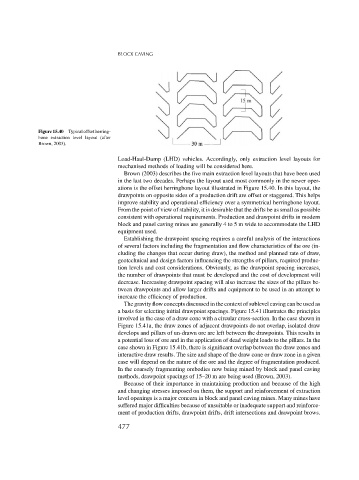Page 495 - Rock Mechanics For Underground Mining
P. 495
BLOCK CAVING
Figure 15.40 Typical offset herring-
bone extraction level layout (after
Brown, 2003).
Load-Haul-Dump (LHD) vehicles. Accordingly, only extraction level layouts for
mechanised methods of loading will be considered here.
Brown (2003) describes the five main extraction level layouts that have been used
in the last two decades. Perhaps the layout used most commonly in the newer oper-
ations is the offset herringbone layout illustrated in Figure 15.40. In this layout, the
drawpoints on opposite sides of a production drift are offset or staggered. This helps
improve stability and operational efficiency over a symmetrical herringbone layout.
From the point of view of stability, it is desirable that the drifts be as small as possible
consistent with operational requirements. Production and drawpoint drifts in modern
block and panel caving mines are generally 4 to 5 m wide to accommodate the LHD
equipment used.
Establishing the drawpoint spacing requires a careful analysis of the interactions
of several factors including the fragmentation and flow characteristics of the ore (in-
cluding the changes that occur during draw), the method and planned rate of draw,
geotechnical and design factors influencing the strengths of pillars, required produc-
tion levels and cost considerations. Obviously, as the drawpoint spacing increases,
the number of drawpoints that must be developed and the cost of development will
decrease. Increasing drawpoint spacing will also increase the sizes of the pillars be-
tween drawpoints and allow larger drifts and equipment to be used in an attempt to
increase the efficiency of production.
The gravity flow concepts discussed in the context of sublevel caving can be used as
a basis for selecting initial drawpoint spacings. Figure 15.41 illustrates the principles
involved in the case of a draw cone with a circular cross-section. In the case shown in
Figure 15.41a, the draw zones of adjacent drawpoints do not overlap, isolated draw
develops and pillars of un-drawn ore are left between the drawpoints. This results in
a potential loss of ore and in the application of dead weight loads to the pillars. In the
case shown in Figure 15.41b, there is significant overlap between the draw zones and
interactive draw results. The size and shape of the draw cone or draw zone in a given
case will depend on the nature of the ore and the degree of fragmentation produced.
In the coarsely fragmenting orebodies now being mined by block and panel caving
methods, drawpoint spacings of 15–20 m are being used (Brown, 2003).
Because of their importance in maintaining production and because of the high
and changing stresses imposed on them, the support and reinforcement of extraction
level openings is a major concern in block and panel caving mines. Many mines have
suffered major difficulties because of unsuitable or inadequate support and reinforce-
ment of production drifts, drawpoint drifts, drift intersections and drawpoint brows.
477

